Summary (English)
Research (2013-2014)
The structure is a fortification typical of a “ quadriburgium ” common between the end of the second and the sixth century AD. The fortification is a small rectangle with angle towers. It is located at a short distance from the “ Cami Vell ” which crosses the island in its whole length between the two headlands. Across the other side of the road one can find the remains of an old tank, whose function was to provide water for the potential users of the fortification. One can reach the site at kilometre 10, towards the south, at about two hundred meters from the road which leads from La Savina to la Mola. A double interrogation hangs over the building date’s and on its use. Most of the materials found during the excavation give a probable chronological span after the landfill of Ibiza’s landfill of “Avenida de España” which has been dated between 240 and 260 AD. Fortresses with similar characteristics in North Africa, have been dated to the Late Roman or the Byzantine period. The second question on Can Blai, regards the possible failure to complete the building, which appears to lack 9 meters of the wall, which raises the question whether this building was really used. The implications of these two questions in the interpretations of the remains are essential. The finds of the 1979 and 1980 excavations could be residues of a site which was built before the construction of the castellum. This means that it could be of the Byzantine period or it could correspond to the use of the fortress, perhaps at the end of the third century or at the fourth century AD. What we are dealing with, presents a double objective: to date precisely the building and determine if it was finished and used. The 1997-1980 research left a good part of the site unexcavated. Despite the weak stratigraphy preserved, a new excavation should allow us to resolve the possible relations between the archaeological layers and the architectural elements of the building.
Works in 2013-14 and projected July 2015:
• Exhaustive excavation of the baulks not excavated during the 1979-1980 interventions.
• Photogrammetric drawing of the site by vertical aerial photography (aerostatical balloon and differential GPS.
• Diagnostic and architectural study of the degradation of the ruins since the last consolidation intervention. Elevation and plan.
• A visibility model from the site in function of the digital elevation model (DEM).
• Thematic survey in the field of 230 ha around the site and preparation of a LIDAR project ( Laser Imaging Detection and Ranging).
• In order to integrate the survey around Can Blai, we plan to create a GIS data-base, with the data from old land surveys conducted by MAEF ( Museu Arqueològic d’Eivissa i Formentera).Descriptive video of the archaeological activities: https://youtu.be/gTckQ62I4zc
- Ricardo González Villaescusa
Director
- Jordi H. Fernández, Museo Arqueológico de Ibiza y Formentera
- Ricardo González Villaescusa, Université de Nice - Sophia Antipolis / CEPAM CNRS
Team
- Frédérique Bertoncello, investigador del CNRS – UMR 7264 CEPAM – UMR 7264 CNRS
- Jorge Fernández Gómez, director del MAEF, director de las excavaciones de Can Blai entre 1979-1980
- Ricardo González Villaescusa, catedrático de Historia Antigua y Arqueología de Université de Nice Sophia – Antipolis Cultures – Environnements. Préhistoire, Antiquité, Moyen Âge). CEPAM – UMR 7264 CNRS-UNS (Cultures – Environnements. Préhistoire, Antiquité, Moyen Âge)
- Sabine Sorin, dibujante científica CNRS, UMR 7264
- Marie-Jeanne Ouriachi, Profesor de Historia romana, especialista en Epigrafía y Arqueología Espacial, Université de Nice Sophia – Antipolis, UMR 7264
- Frédéric Gayet, Profesor de Historia romana, especialista en Ejército romano, Université de Nice Sophia – Antipolis, UMR 7264
- Alejandro Quevedo Sánchez, CNRS – Aix-en-Provence, especialista en cerámica africana
- Gourguen Davtian, Ingeniero, geomático CNRS, (SIG, Teledetección, GPS) – UMR 7264
Research Body
- Université de Nice – Sophia Antipolis, Museo Arqueológico de Ibiza y Formentera
Funding Body
- Fondation de l’Université de Nice, UNICE, Consell Insular de Formentera, Museo Arqueológico de Ibiza y Formentera






![Download [PDF]](/excavation/skins/fasti/images/results/download_sml.png)